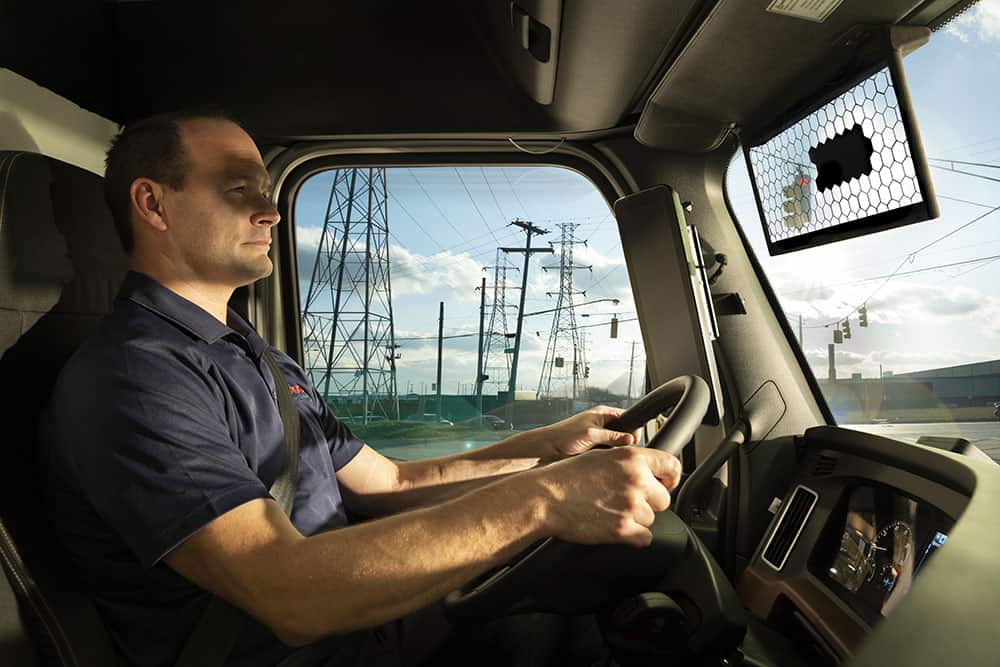CES 2020: Virtual Visor precisely blocks blinding sun

Story by: Alan Adler @ FreightWaves.com
Largely unchanged since its invention nearly a century ago, the lightly regarded sun visor often frustrates drivers as much as it shields glare.
Higher-riding truck drivers are so susceptible to sun coming directly at them that they spend hundreds of dollars to affix exterior drop visors that resemble the bill of a baseball cap.
German auto supplier Robert Bosch is showing an invention at CES 2020 in Las Vegas called Virtual Visor that replaces the traditional sun visor with a single transparent liquid crystal display (LCD) married to a driver-monitoring camera and facial tracking software.
How it works
Virtual Visor uses artificial intelligence to locate the driver within the image from the driver-facing camera and determine facial landmarks — eyes, nose, mouth and even facial hair — to identify shadows on the face. An algorithm analyzes the driver’s view, darkening only the section of the display through which light hits the driver’s eyes.
The rest of the display remains transparent, removing the obstruction of a large section of the driver’s field of vision. As the vehicle moves, the system adjusts to shield the driver’s eyes.
“We discovered early in the development that users adjust their traditional sun visors to always cast a shadow on their own eyes,” said Jason Zink, a Bosch technical expert and one of the co-creators of Virtual Visor. It was an “aha moment” as profound as the discovery itself.
The idea for Virtual Visor came to Bosch powertrain engineer Ryan Todd in 2016 as he struggled to keep the rising sun out of his eyes on his daily eastbound commute from Ann Arbor, Michigan, to work in the Detroit suburb of Farmington Hills.
He took his idea for a better way to block the sun to an internal incubator where Bosch employees are encouraged to come up with cost-effective benefits for customers. The best pass peer evaluation and get funding for development.
Todd and Zink built the first prototype from a discarded LCD monitor they found in a recycling bin.
Other prototypes followed, winning support from higher-ups. Eventually, Virtual Visor got the green light for production.
Zink, a powertrain engineer like Todd, followed the Virtual Visor from concept to its transition to the Bosch Car Multimedia division where he now works.
 Ryan Todd (L) and Jason Zink (R) work with the prototype of the Virtual Visor they co-created at Robert Bosch. Virtual Visor uses a single pane LCD, a driver-focused camera and facial tracking software to pinpoint where the sun should be shielded from a driver’s eyes. (Photo: Bosch)
Ryan Todd (L) and Jason Zink (R) work with the prototype of the Virtual Visor they co-created at Robert Bosch. Virtual Visor uses a single pane LCD, a driver-focused camera and facial tracking software to pinpoint where the sun should be shielded from a driver’s eyes. (Photo: Bosch)
“We’ve built a culture around empowering our associates by putting them in the driver’s seat,” said Mike Mansuetti, president of Bosch in North America. “We understand that innovation can come from any level of an organization and we want to see that grow.”
Virtual Visor is being pitched to passenger car and commercial truck makers, though Bosch declines to name the interested companies.
“We think commercial vehicles will be one of our best markets,” Todd said. “If this replaces the external drop visor, the cost could be less than they are paying now.”
Nikola Motors, which plans an ultra-modern fuel cell-powered Class 8 truck in 2022, could be a candidate. Bosch has more than 50 engineers embedded with Nikola working on a range of components. Jason Roycht, former head of off-highway products for Bosch, recently joined Nikola as head of business development.
Safety implications
Temporary blindness from the sun causes twice as many accidents as any other weather condition, according to Bosch. Another study found the risk of a life-threatening crash was 16% higher during bright sunlight than normal weather.
One potential safety benefit of Virtual Visor, which weighs about the same as a traditional visor, is that a driver can set it and forget it. Constant flipping a traditional visor up and down can contribute to distracted driving.
“The key benefit is that it’s automatic,” Zink said. “And we feel that’s going to have a positive impact on safety.”
As technology like Virtual Visor intersects with Level 4 automated driving, it will still be relevant to a driver in the cab, Zink said.
“If you’re sitting there reading a magazine or something, you’ll still have the same need,” he said. “You don’t want the sun to be shining in your eyes.”
Virtual Visor received the highest ratings from a panel of designers, engineers and technology media in being named the CES 2020 Best of Innovation in the In-Vehicle Entertainment & Safety category.
Read the original story HERE @ freightwaves.com
Source and credits: freightwaves.com /Alan Adler / iTrucker / Mario Pawlowski



